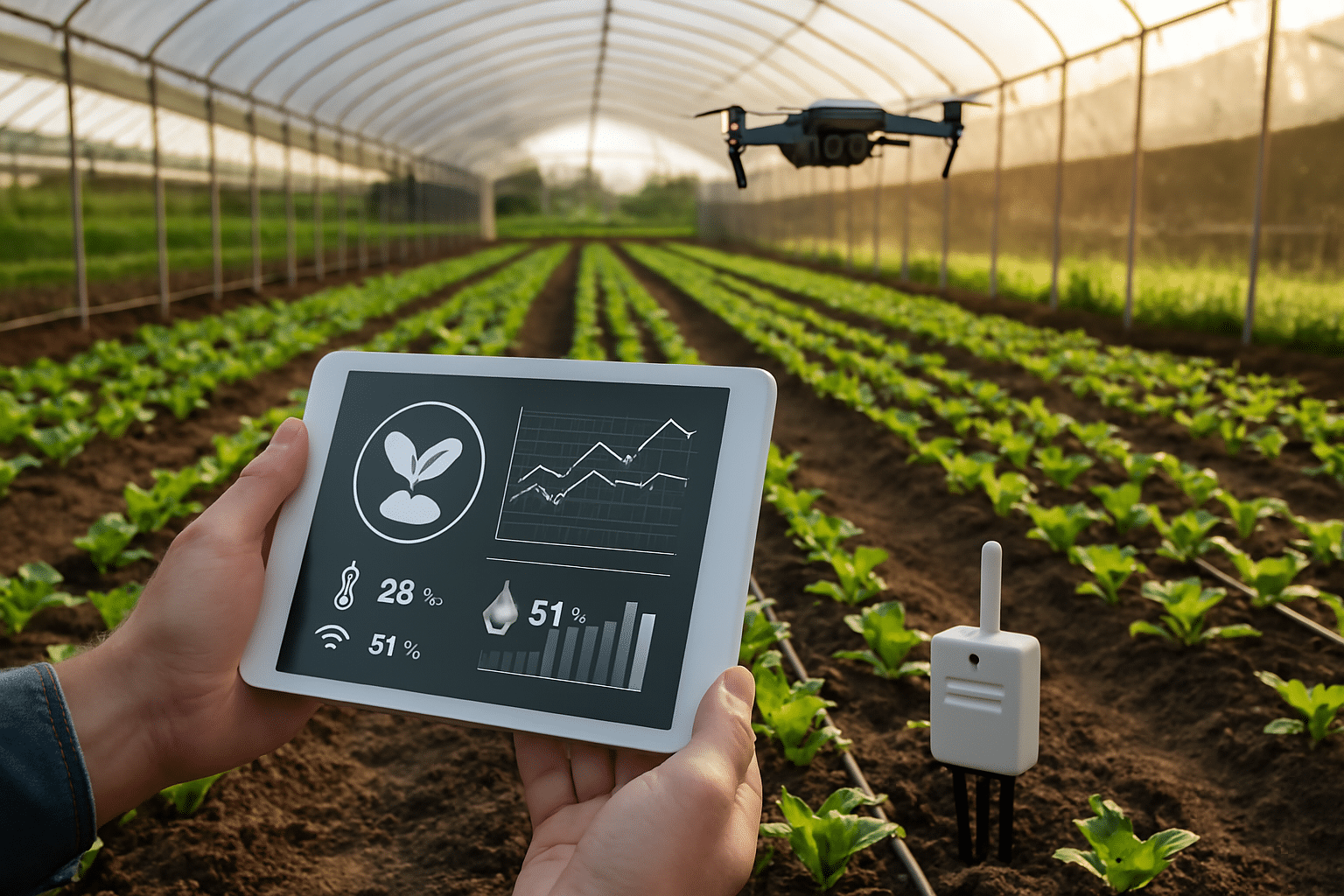Key Takeaways:
- Smart farming combines data, sensors, IoT, and AI to improve decision-making and resource efficiency.
- Technologies like drones, robotics, and AI-driven analytics help optimize crop yield and reduce environmental impact.
- Despite its benefits, challenges such as high costs, data security, and infrastructure gaps remain.
- Best practices include scalable implementation, partnerships, and continuous monitoring.
- Countries like Indonesia are seeing tangible results from smart greenhouse initiatives, showcasing global potential.
What is Smart Farming?
Smart farming, also known as smart agriculture, is a modern approach that combines advanced technologies to improve the efficiency, productivity, and sustainability of agricultural operations. It incorporates tools such as the Internet of Things (IoT), drones, artificial intelligence (AI), big data analytics, and robotics to enable more precise and responsive farm management.
By using real-time data from sensors, aerial imaging, and predictive analytics, farmers can make more informed decisions about planting, irrigation, fertilization, pest control, and harvesting. This data-driven methodology may contribute to improved yields, optimized resource use, and the ability to respond to evolving challenges such as climate change and resource scarcity. Smart farming is a core element of precision agriculture.
Key Technologies in Smart Farming
Internet of Things (IoT) Sensors and Devices
IoT-enabled sensors are designed to collect real-time data on key parameters such as soil moisture, temperature, crop health, and nutrient levels. These insights can help inform farming practices and guide resource allocation.
Drones and Aerial Imaging
Drones enable efficient crop surveillance and imaging, helping identify irrigation needs, pest infestations, and disease outbreaks. High-resolution imagery supports more targeted interventions.
Robotics and Automated Machinery
Technologies such as autonomous tractors and robotic harvesters help reduce manual labor and improve task efficiency. These machines are typically programmed to perform repetitive tasks with consistency.
Data Analytics and Artificial Intelligence (AI)
Data analytics platforms, enhanced by AI, process large volumes of information to identify trends and generate recommendations. Predictive models may assist in planning crop cycles or mitigating potential risks.
Benefits of Smart Farming
Increased Agricultural Productivity
Some studies suggest that smart farming can contribute to higher productivity by improving crop planning, monitoring, and input management. In one case from Thailand, adoption of smart farming practices aligned with national productivity goals.
Environmental Sustainability
Smart farming technologies can support sustainable agricultural practices by minimizing input waste, optimizing pesticide and water use, and encouraging precision in resource deployment.
Operational Efficiency and Cost Reduction
Automation and digital systems may help streamline operations, reduce manual input, and optimize the use of fertilizers, water, and labor. In some cases, this can contribute to lower operational costs.
Data-Driven Decision Making
Technologies such as IoT sensors and UAVs gather detailed environmental data, which can inform decisions on irrigation schedules, pest control strategies, and planting cycles.
Enhanced Accuracy and Precision
Smart systems aim to improve accuracy in planting, input application, and environmental monitoring—potentially supporting more consistent results across growing seasons.
Challenges of Smart Farming
High Initial Investment and Maintenance Costs
Deploying smart farming systems often requires substantial upfront investment in equipment, infrastructure, and training.
Data Security and Privacy Concerns
Managing digital data introduces concerns around cybersecurity, data ownership, and compliance with regulations.
Limited Digital Infrastructure in Rural Areas
Connectivity and technical infrastructure gaps in rural regions may limit adoption, especially for smaller farms.
Training and Skill Development for Farmers
Adopting new technologies may require farmers to gain new skills or access technical support to use the tools effectively.
Best Practices for Smart Farming
1. Conducting a Technology Needs Assessment
Before implementing smart farming technologies, it is essential to assess the specific needs of a farm. This includes evaluating crop types, climate conditions, infrastructure availability, and budget. A tailored approach ensures relevant technologies are selected.
2. Precision Farming Techniques
Using IoT sensors and drones, farmers can collect real-time data on soil moisture, temperature, crop health, and weather. Precision irrigation systems can reduce water use by up to 60% by adjusting flow based on soil conditions and forecasts.
3. Data Management and Analytics
Cloud-based platforms allow integration of various data sources to support decision-making. AI and machine learning can analyze this data to generate predictive insights, improving yield forecasting and resource allocation.
4. Automation and Robotics
Automated machinery can perform tasks such as planting, watering, and harvesting with minimal manual intervention. This not only lowers labor costs but also enhances consistency and productivity. In greenhouse and vertical farming, automation helps optimize spatial use and environmental controls.
5. Climate-Smart and Sustainable Practices
Integrated Pest Management (IPM), precision fertilization, and sustainable livestock practices contribute to reducing chemical use and environmental impact. These methods can also improve biodiversity and soil health.
6. Smart Farming & Adaptation to Climate Change
Advanced weather monitoring and resilient agricultural practices—such as drought-resistant crop varieties and smart irrigation—enable farms to better withstand climate variability.
Case Studies and Success of Smart Farming
An example of practical implementation is Indonesia's smart greenhouse program, which demonstrated the potential of IoT-enabled systems in improving greenhouse efficiency.
Additional examples are available in iGrow News' AgTech news, featuring various applications of smart farming technologies across different scales and contexts.
The Future of Smart Farming
As technologies evolve and become more cost-accessible, smart farming may see broader adoption. Integration with AI, machine learning, and cloud platforms could further enable data-informed, automated farm management.
Future developments may include deeper integration of renewable energy, expanded crop monitoring capabilities, and improved support systems for remote or resource-limited areas. While opportunities are expanding, outcomes will depend on how technologies are implemented, supported, and maintained.
Learn More on Smart Farming
Explore our full directory of smart farming solutions, technologies, and news here. For additional insights, visit our article on precision agriculture.
Stay informed with the latest AgTech news to track ongoing innovation in agriculture and food systems. Subscribe to our weekly digest at agtechdigest.com


